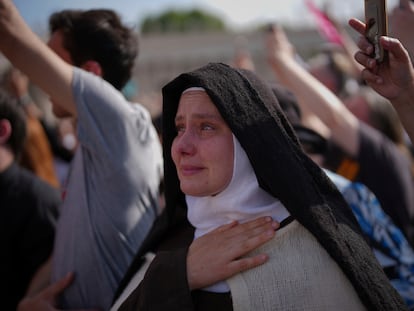World leaders and faithful bid farewell to Pope Francis as the Church prepares to choose his successor
400,000 people attended the funeral in St. Peter’s Basilica and watched the procession through Rome. As he spoke before delegations from 146 countries, the dean of the cardinals recalled the Pontiff’s message: “Build bridges, not walls”
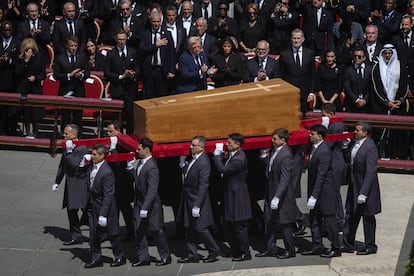
“He was a Pope in the midst of the people.” The dean of the cardinals, Giovanni Battista Re, described Pope Francis as such during the Pontiff’s funeral this Saturday. Francis died on Monday at the age of 88 after 12 years of an intense pontificate that has shaken the Church. The ceremony drew a huge crowd: 400,000 people, according to the authorities, adding those who came to St. Peter’s Square (250,000) and to the funeral procession through the city (150,000). An overwhelming response of popular affection for a Pope sometimes more understood and loved in the streets and in neighborhood parishes than in his own offices and those of governments. On the esplanade outside the Vatican Basilica, there were delegations from 146 countries, with 10 monarchs and 50 heads of state and government. Many of them criticized him, even insulted him, like Javier Milei, president of Argentina, who was in the front row closest to the coffin.
Francis spoke out against the policies of many of those present: the American Donald Trump, the Italian Giorgia Meloni, the Hungarian Viktor Orbán, the German Ursula von der Leyen and a whole global political class that makes war, neglects the planet, rejects immigrants and forgets poverty. A world in crisis, in fear and in tension, in which Jorge Mario Bergoglio’s passing leaves a void that the Church must now rush to fill. They will decide who will replace him, as a question lingers: will they elect someone who can speak both to the poor and the neglected, as well as the most powerful people in the world, as Francis did? Because in the end, they all come to say goodbye to him.
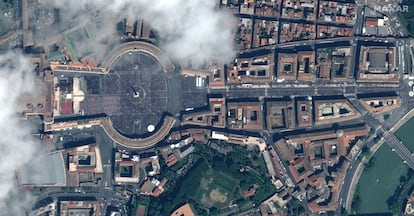
Almost 5,000 clerics attended the monumental ritual: on the left of the altar, 220 cardinals resembled a sea of red and white cloth, which contrasted with the dark mourning clothes worn by those on the right. A large crowd stretched along the Via della Conciliazione, with several giant screens to follow the ceremony. A beautiful Roman sky, blue and cloudy, and a light breeze turned the pages of the Gospel left on Francis’ wooden coffin.
Former U.S. president Joe Biden was one of the first to arrive, before nine in the morning. Trump had a little trouble walking down the stairs, hand in hand with his wife, and was sat near the King and Queen of Spain, separated only by Estonian president Alar Karis. Melania went over to greet Queen Letizia. There was a bit of confusion because both Trump and the French president, Emmanuel Macron, and others were supposed to be in the back rows, but in the end they sat in the first one. Trump’s huge, blond figure stuck out among the rest. Russia was represented by the country’s Minister of Culture, Olga Borisovna Lyubimova.
A whole parallel diplomacy of handshakes soon unfolded discreetly, the first one being between Trump and von der Leyen, president of the European Commission. And it soon became known that the U.S. president had just met with the Ukrainian Volodymyr Zelenskiy. By the end of the Mass, the photos had already been published: the two sat in red and gold chairs, facing each other, in a solitary marble corner of the basilica. One of the most significant images of the day, that had nothing to do with the funeral. The meeting may not have gone down well in the Vatican, but if it serves to obtain peace in Ukraine, Francis would have probably been delighted to see it forged on the spot. Among the cardinals present at the funeral was Joseph Zen Ze-Kiun, Archbishop Emeritus of Hong Kong, arrested in 2022 and released on bail, who was finally able to travel to Rome.
Before Francis’ coffin was carried outside the basilica, his small Vatican family bid him farewell. His secretaries and assistants Juan Cruz Villalon, Manuel Pellizzon and Fabio Salerno. Also his nurse Massimiliano Strappetti, and valets Piergiorgio Zanetti and Daniele Cherubini. They kissed the coffin before departing. Among Bergoglio’s relatives was the Salesian nun Ana Rosa Sivori, 82, a distant cousin who lives in Thailand.
The homily in Italian by Cardinal Re, whose strong Brescia accent boomed over the loudspeakers, once again made the heads of state and government hear Francis’ words even in death: “‘Build bridges, not walls’ was an exhortation [Francis] repeated many times,” he said. The crowd applauded as the politicians present remained unperturbed.
He recalled Francis’ fierce defense of migrants, when he traveled to the island of Lampedusa and celebrated mass on the border between Mexico and the United States. The crowd continued to applause, though the biggest ovation came when Re mentioned Francis’ encyclical on the environment and the need to care for the planet. Looking up at the crowd, Cardinal Re said the great outpouring of affection these days shows “how much the intense pontificate of Pope Francis has touched minds and hearts.” The ceremony, which included prayers in Arabic and Mandarin, ended at noon.
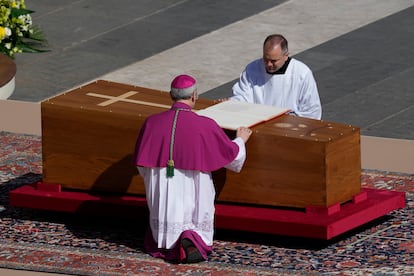
When the coffin entered the basilica at 12:15 p.m., the bells announcing his death began to ring throughout Rome, and with that slow cadence the square began to empty. For security reasons, the delegations of the United States, Ukraine and Palestine left first, as well as those of France, Spain, Prince William of England, Brazil, and the President of the Italian Republic, Sergio Mattarella. The others had to wait for the hearse to leave the Vatican.
Francis’ last trip by popemobile to the Basilica of Santa Maria Maggiore, where he was buried, began at 12:26 pm. The coffin was placed in a white vehicle with license plate SCV1, escorted by four motorcycles of Carabinieri and Police and followed by a row of vehicles. In two minutes he left the Vatican territory and outside the walls, people were already waiting for him. They greeted him with an applause that did not die down during the half hour trip. Similar cries were heard along the way: “Bravo!”; “Long live the Pope”; and above all, “Grazie!”.
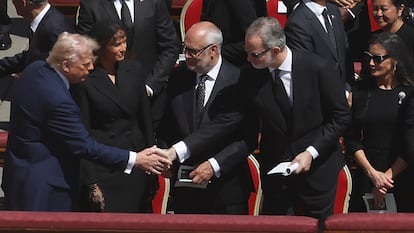
Aerial images reflected the beauty of Rome in springtime, the domes, the palaces, the pine trees, the river. Bells tolled as the funeral procession passed through the hundreds of churches in the historical city. People leaned out of windows. Some officers stood at attention and gave Francis a last salute with a hand to their foreheads.
In its farewell to the city, the funeral procession passed through Largo Argentina, the ruins of where Julius Caesar was assassinated. It also drove past the mother church of the Jesuits, the Gesù, and through Piazza Venezia. It then turned toward the Imperial Forums, with the Colosseum in the background, the most evocative scene, crossing more than two millennia of history, the heart of the empire where the Church germinated and grew, at first a small sect, until it became master of the city itself. Italy then turned against the Vatican. And after the occupation of Rome, Pius IX declared himself a prisoner within the walls of the Holy See. He began to slowly understand modernity and its new place in the world — a process continues to this day, with Francis having taken one more step towards it. Who will take the next one will be known in a few days.
The applause ceased upon his arrival at Santa Maria Maggiore, at 12:55 p.m. Four Swiss guards were waiting, something rare to see outside the Vatican. Also, fifty people whom Francis has helped over the years — immigrants, refugees, the homeless, and trans prostitutes, the last ones to whom he dedicated his strength. They all waited with a white rose in hand.

The rogito, a brief summary of the life of the deceased, was placed inside the coffin on Friday. It says in one of its paragraphs: “He was a simple and much loved pastor in his archdiocese, who moved from here to there, also by subway and bus. He lived in an apartment and prepared his own dinner, because he felt he was one of the people.” It added that he was always attentive “to those discarded by society” and that he recommended to priests “to have the courage to leave the sacristy.” It concluded: “He lived 88 years, four months and four days. He has been head of the universal Church for 12 years, one month and eight days.”
At 1:30 p.m. a marble tombstone from Liguria, the region of Genoa from which his grandparents emigrated from to Argentina at the beginning of the 20th century, was placed on his tomb. Bergoglio always spoke about how much it marked him to know that the first ship they were going to take, the Princesse Mafalda, was shipwrecked in 1927. They were saved because at the last minute they changed their ticket. It always shocked him to think that he might not have been here. But he was here, and both the most powerful of the world and ordinary people came together to bid him farewell.
Tu suscripción se está usando en otro dispositivo
¿Quieres añadir otro usuario a tu suscripción?
Si continúas leyendo en este dispositivo, no se podrá leer en el otro.
FlechaTu suscripción se está usando en otro dispositivo y solo puedes acceder a EL PAÍS desde un dispositivo a la vez.
Si quieres compartir tu cuenta, cambia tu suscripción a la modalidad Premium, así podrás añadir otro usuario. Cada uno accederá con su propia cuenta de email, lo que os permitirá personalizar vuestra experiencia en EL PAÍS.
¿Tienes una suscripción de empresa? Accede aquí para contratar más cuentas.
En el caso de no saber quién está usando tu cuenta, te recomendamos cambiar tu contraseña aquí.
Si decides continuar compartiendo tu cuenta, este mensaje se mostrará en tu dispositivo y en el de la otra persona que está usando tu cuenta de forma indefinida, afectando a tu experiencia de lectura. Puedes consultar aquí los términos y condiciones de la suscripción digital.
More information
Archived In
Últimas noticias
Chris Martin, Taylor Swift, Elijah Wood and other famous wedding ‘crashers’
‘How does it feel to be a failure?’: Elizabeth Berkley’s journey from ‘Showgirls’ ridicule to vindication
The story of the Málaga virus: The code that haunted Google’s cybersecurity center director for 30 years
The impact of Ecuador’s mega-prison: A polluted river, cleared forests and military checkpoints
Most viewed
- Christian Louboutin: ‘Young people don’t want to be like their parents. And if their parents wear sneakers, they’re going to look for something else’
- The low-cost creative revolution: How technology is making art accessible to everyone
- Liset Menéndez de la Prida, neuroscientist: ‘It’s not normal to constantly seek pleasure; it’s important to be bored, to be calm’
- All the effects of gentrification in one corner of Mexico’s Colonia Roma
- December Social Security and SSI payments: Dates, double checks and the 2026 COLA increase


